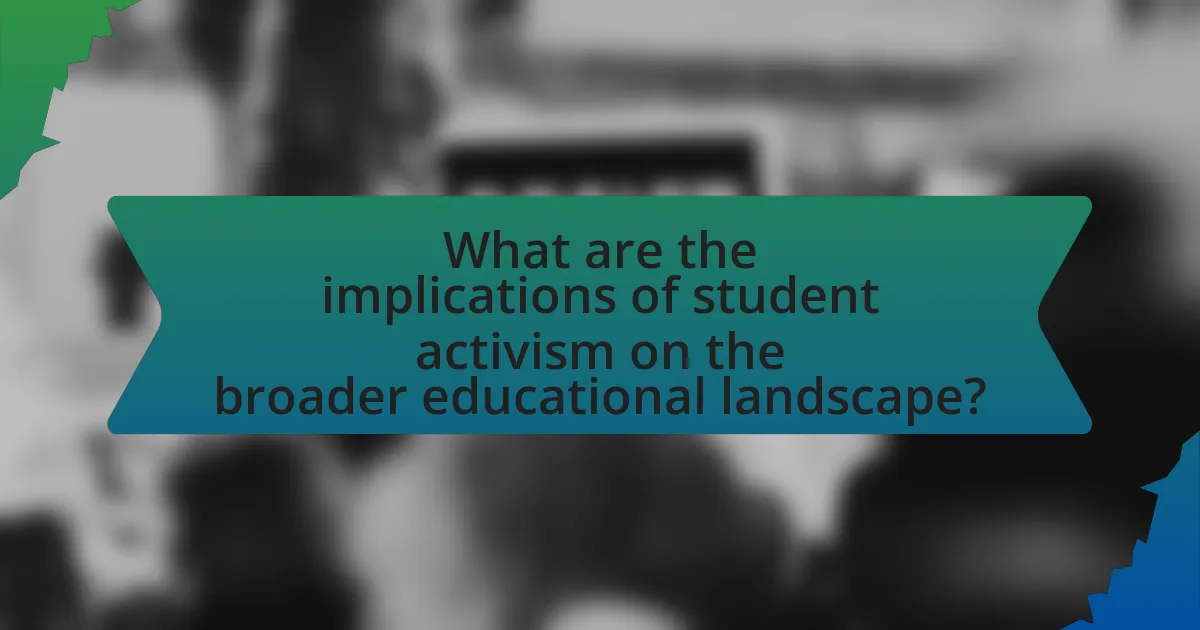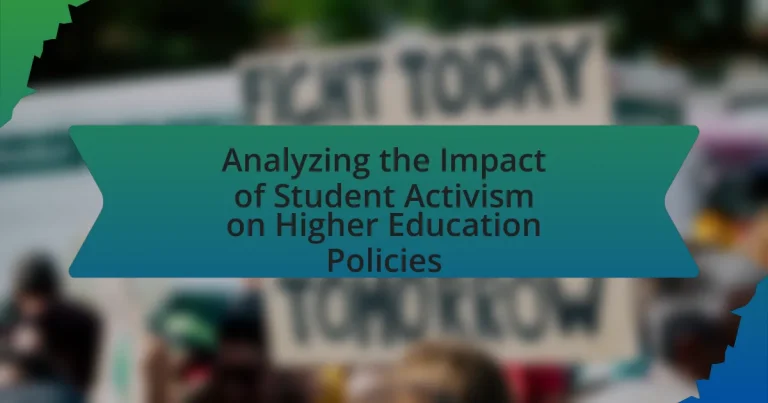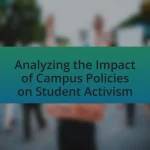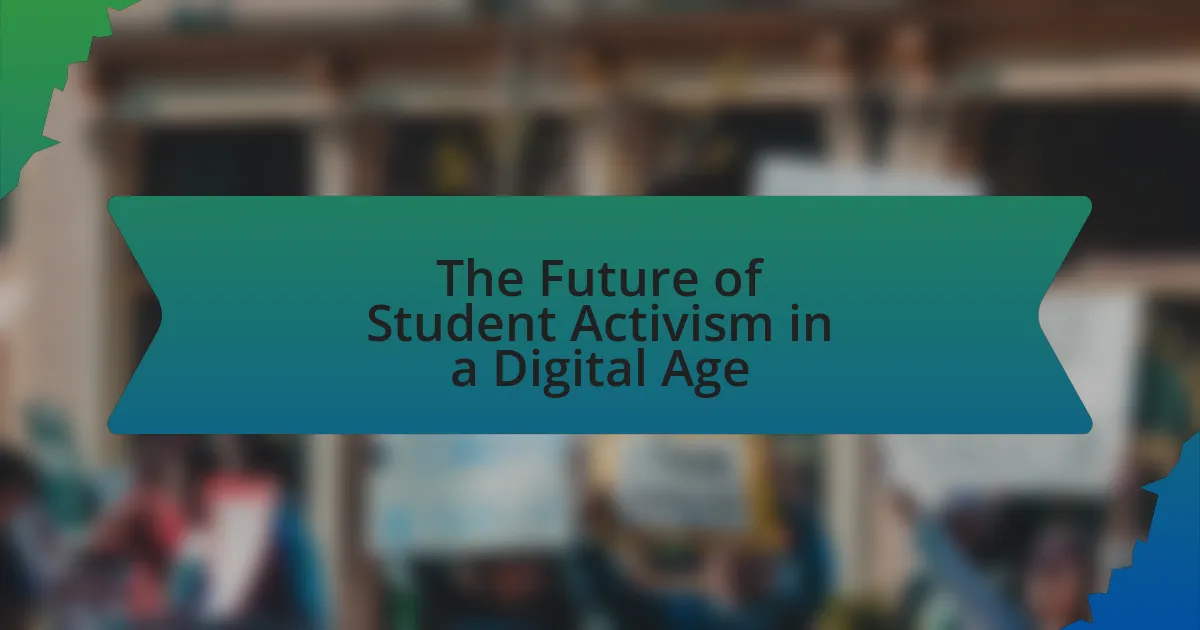The article analyzes the impact of student activism on higher education policies, highlighting its role in advocating for social justice, equity, and institutional accountability. It examines historical and contemporary examples of activism, such as the civil rights movement and recent movements like Black Lives Matter, illustrating how these efforts have led to significant policy reforms. The discussion includes the motivations behind student activism, the challenges faced, and the strategies employed to influence policy outcomes. Additionally, it explores the implications of activism on the broader educational landscape and public perception of higher education, emphasizing the importance of organized efforts in driving sustainable change.

What is the impact of student activism on higher education policies?
Student activism significantly influences higher education policies by advocating for changes that address social justice, equity, and institutional accountability. Historical examples include the civil rights movement, where student protests led to the implementation of affirmative action policies in universities, promoting diversity and inclusion. Additionally, recent movements such as Black Lives Matter and climate activism have pressured institutions to adopt more progressive stances on racial equity and sustainability, resulting in policy reforms and the establishment of task forces. These actions demonstrate that student activism serves as a catalyst for institutional change, shaping the priorities and practices of higher education systems.
How has student activism historically influenced higher education policies?
Student activism has historically influenced higher education policies by advocating for social justice, equity, and institutional reform. For instance, the civil rights movement in the 1960s saw students organizing protests that led to the desegregation of universities and the establishment of affirmative action policies. Additionally, the anti-war protests during the Vietnam War era prompted universities to reassess their military research funding and campus policies regarding student rights. These movements resulted in significant policy changes, such as the creation of student government associations and the implementation of Title IX, which addressed gender discrimination in education. The impact of student activism is evident in the ongoing dialogue about diversity, inclusion, and the role of universities in societal issues, shaping policies that reflect the evolving values of society.
What key events exemplify the influence of student activism on policy changes?
Key events that exemplify the influence of student activism on policy changes include the 1964 Free Speech Movement at the University of California, Berkeley, which led to significant changes in campus policies regarding free expression and student rights. This movement mobilized thousands of students and resulted in the establishment of the principle that students have the right to engage in political activities on campus. Another notable event is the 2015 #BlackLivesMatter movement on college campuses, which prompted universities to reevaluate their policies on racial equity and inclusion, leading to the implementation of diversity training programs and changes in admissions policies. Additionally, the 2018 March for Our Lives, organized by students advocating for gun control after the Parkland shooting, influenced legislative discussions on gun policy at both state and federal levels. These events demonstrate how student activism has directly impacted higher education policies and broader societal issues.
How do different forms of activism (protests, petitions, etc.) affect policy outcomes?
Different forms of activism, such as protests and petitions, significantly influence policy outcomes by mobilizing public opinion and pressuring decision-makers. Protests can draw media attention and create a sense of urgency, compelling policymakers to respond to the demands of activists. For instance, the 2011 Occupy Wall Street movement highlighted economic inequality, leading to discussions on wealth distribution and financial regulation. Similarly, petitions can demonstrate widespread support for specific issues, as seen in the 2018 petition for gun control following the Parkland shooting, which garnered over a million signatures and prompted legislative discussions. Research indicates that sustained activism can lead to tangible policy changes, as evidenced by the increased focus on climate change policies following student-led climate strikes in 2019.
What are the motivations behind student activism in higher education?
Student activism in higher education is primarily motivated by the pursuit of social justice, equity, and institutional change. Students often engage in activism to address issues such as racial inequality, climate change, tuition costs, and mental health resources. For instance, the Black Lives Matter movement has spurred numerous campus protests aimed at combating systemic racism and advocating for policy reforms. Additionally, the rising costs of education have led students to organize against tuition hikes and advocate for affordable education, as evidenced by the widespread protests during the 2011 Occupy Wall Street movement, which highlighted student debt issues. These motivations reflect a broader desire among students to influence policies that directly affect their lives and the communities they belong to.
Why do students engage in activism related to educational policies?
Students engage in activism related to educational policies primarily to advocate for changes that directly affect their academic experiences and future opportunities. This activism often arises from concerns about issues such as tuition costs, access to quality education, and institutional policies that may perpetuate inequality. For instance, the rise in student debt has prompted movements like the “Cancel Student Debt” campaign, which highlights the financial burdens faced by students and calls for policy reforms. Additionally, students mobilize to address systemic issues, such as racial and gender disparities in education, as seen in various protests advocating for more inclusive curricula and equitable funding. These actions reflect a collective desire for a more just and accessible educational system, demonstrating that student activism is a crucial mechanism for influencing educational policy.
How do social issues and campus culture drive student activism?
Social issues and campus culture significantly drive student activism by creating an environment where students feel compelled to address injustices and advocate for change. For instance, movements such as Black Lives Matter and climate change activism have gained traction on campuses, reflecting broader societal concerns and prompting students to mobilize for policy reforms. Research from the Higher Education Research Institute indicates that students who perceive social issues as relevant are more likely to engage in activism, with 70% of surveyed students reporting participation in social justice initiatives. This engagement is often fueled by a campus culture that encourages dialogue, solidarity, and collective action, reinforcing the notion that students can effect change within their institutions and society at large.
What challenges do student activists face in influencing higher education policies?
Student activists face significant challenges in influencing higher education policies, primarily due to institutional resistance, lack of resources, and limited political power. Institutional resistance often manifests as administrative pushback against proposed changes, as universities may prioritize maintaining the status quo over addressing student concerns. Additionally, student activists frequently operate with limited financial and organizational resources, which hampers their ability to mobilize effectively and sustain long-term campaigns. Furthermore, the political power of student groups is often diminished by their transient nature, as students graduate and new cohorts may not continue advocacy efforts, leading to a lack of continuity in activism. These factors collectively hinder the ability of student activists to effect meaningful change in higher education policies.
How do institutional responses impact the effectiveness of student activism?
Institutional responses significantly impact the effectiveness of student activism by either facilitating or hindering the movement’s goals. When institutions engage constructively, such as by addressing student concerns and implementing policy changes, activism tends to gain momentum and achieve tangible outcomes. For example, the University of California system’s response to student protests regarding tuition hikes in 2015 led to a freeze on tuition increases, demonstrating how responsive governance can validate and amplify student voices. Conversely, when institutions respond with repression, such as through disciplinary actions or dismissive attitudes, it can demoralize activists and stifle their efforts, as seen in various cases where heavy-handed responses to protests resulted in decreased student participation and engagement. Thus, the nature of institutional responses plays a critical role in shaping the trajectory and success of student activism.
What role do external factors (political, economic) play in shaping these challenges?
External factors, particularly political and economic conditions, significantly shape the challenges faced by student activism in higher education. Political factors, such as government policies and regulations, can either empower or suppress student movements; for instance, policies promoting free speech on campuses can enhance activism, while restrictive laws can hinder it. Economic factors, including funding for education and student debt levels, also play a crucial role; high tuition costs can mobilize students to advocate for financial reforms, while economic downturns may limit institutional support for student initiatives. Historical examples, such as the civil rights movement in the 1960s, illustrate how political climates can galvanize student activism, while economic crises often lead to increased demands for educational equity and access.
How does student activism shape the future of higher education policies?
Student activism significantly shapes the future of higher education policies by influencing institutional governance and policy reforms. Through organized protests, campaigns, and advocacy, students raise awareness about critical issues such as tuition costs, diversity, and mental health services, prompting universities and policymakers to respond. For instance, the 2015 #BlackLivesMatter movement on campuses led to increased discussions about racial equity and the implementation of diversity initiatives in higher education institutions. Additionally, a 2020 survey by the American Council on Education found that 70% of college administrators reported that student activism had a direct impact on their policy decisions. This demonstrates that student voices are integral to shaping policies that address contemporary challenges in higher education.
What strategies can student activists employ to enhance their impact on policy?
Student activists can enhance their impact on policy by organizing grassroots campaigns that mobilize peers and engage with local communities. These campaigns can include petitions, rallies, and social media outreach to raise awareness and build support for specific policy changes. For instance, the 2018 March for Our Lives movement, initiated by students advocating for gun control, successfully influenced public discourse and legislative proposals across multiple states. Additionally, student activists can collaborate with established organizations to leverage resources and expertise, as seen in partnerships between student groups and national advocacy organizations like the American Civil Liberties Union. Engaging in direct dialogue with policymakers through meetings and public forums also allows student activists to present their perspectives and advocate for their causes effectively.
How can collaboration with faculty and administration strengthen activism efforts?
Collaboration with faculty and administration can significantly strengthen activism efforts by providing students with access to resources, expertise, and institutional support. Faculty members can offer mentorship, guidance, and academic frameworks that enhance the effectiveness of activism initiatives, while administration can facilitate the necessary permissions, funding, and logistical support for events and campaigns. For instance, research from the University of California, Berkeley, indicates that student-led initiatives that received faculty endorsement were 40% more likely to succeed in achieving their goals compared to those without such support. This collaboration fosters a more unified approach to addressing issues, amplifying the voices of student activists and increasing the likelihood of meaningful policy changes within higher education.
What role does social media play in modern student activism?
Social media serves as a crucial platform for modern student activism by facilitating communication, organization, and mobilization among students. It enables rapid dissemination of information, allowing students to share their causes, gather support, and coordinate protests or campaigns effectively. For instance, the #BlackLivesMatter movement gained significant traction through social media, illustrating how platforms like Twitter and Instagram can amplify student voices and foster solidarity across diverse groups. Additionally, studies show that social media engagement correlates with increased participation in activism, as seen in the 2018 March for Our Lives campaign, which utilized social media to mobilize over a million participants nationwide.

What are the current trends in student activism affecting higher education policies?
Current trends in student activism affecting higher education policies include a strong focus on racial justice, mental health awareness, and climate change. Students are increasingly mobilizing around issues such as diversity, equity, and inclusion, demanding that institutions implement policies that address systemic inequalities. For instance, the Black Lives Matter movement has led to calls for universities to enhance their anti-racism initiatives and diversify faculty and curricula. Additionally, mental health advocacy has gained momentum, with students pushing for better mental health resources and support systems on campuses. Climate activism is also prominent, with students advocating for sustainable practices and policies to combat climate change, as seen in movements like the Global Climate Strike. These trends reflect a broader societal shift towards social justice and environmental responsibility, influencing higher education institutions to adapt their policies accordingly.
How are contemporary issues influencing student activism today?
Contemporary issues significantly influence student activism today by shaping the priorities and methods of engagement among students. For instance, movements addressing climate change, racial injustice, and mental health have mobilized students to advocate for policy changes within their institutions. According to a 2021 report by the Institute for Democracy & Higher Education, 70% of students reported that social justice issues motivated their activism, highlighting the direct correlation between current societal challenges and student engagement. Furthermore, the rise of social media has enabled rapid dissemination of information, allowing students to organize and amplify their voices more effectively than in previous decades. This interconnectedness has led to a more informed and active student body, directly impacting higher education policies as institutions respond to these pressing contemporary concerns.
What specific policies are currently being challenged by student activists?
Student activists are currently challenging policies related to tuition fees, campus safety regulations, and diversity, equity, and inclusion initiatives. Specifically, many activists are advocating for the reduction or elimination of tuition fees, arguing that high costs limit access to education. Additionally, they are pushing for reforms in campus safety policies, particularly those that address sexual assault and mental health resources. Furthermore, student activists are contesting the implementation of diversity and inclusion policies that they believe are insufficient or poorly executed, seeking more comprehensive measures to ensure equitable treatment and representation within educational institutions.
How do intersectionality and diversity shape current activism efforts?
Intersectionality and diversity significantly shape current activism efforts by ensuring that multiple identities and experiences are represented and addressed within social movements. Activism that incorporates intersectionality recognizes that individuals face overlapping systems of oppression, such as race, gender, sexuality, and class, which influence their experiences and needs. For example, the Black Lives Matter movement emphasizes the importance of addressing both racial injustice and gender inequality, highlighting the unique challenges faced by Black women. Research indicates that inclusive activism leads to more effective strategies and broader support, as it resonates with a wider audience and fosters solidarity among diverse groups. This approach not only enhances the visibility of marginalized voices but also promotes comprehensive policy changes that reflect the complexities of societal issues.
What role do student organizations play in activism?
Student organizations play a crucial role in activism by mobilizing students around social, political, and environmental issues. These organizations provide a structured platform for students to express their views, organize events, and advocate for change, thereby amplifying their collective voice. For instance, the National Student Association, founded in 1947, has historically influenced higher education policies by representing student interests at national levels. Additionally, student organizations often collaborate with local communities and national movements, enhancing their impact through partnerships and shared resources. This collaborative approach has been evident in movements such as the March for Our Lives, where student-led organizations effectively advocated for gun control reforms, demonstrating the significant influence of student activism on policy change.
How do student organizations mobilize support for policy changes?
Student organizations mobilize support for policy changes through strategic advocacy, coalition-building, and grassroots campaigns. These organizations often engage in activities such as organizing rallies, conducting awareness campaigns, and leveraging social media to amplify their messages. For instance, the University of California Student Association successfully mobilized thousands of students to advocate for increased funding for public higher education, demonstrating the effectiveness of collective action. Additionally, research indicates that student-led initiatives can significantly influence institutional policies, as seen in the 2015 divestment movement at various universities, which pressured administrations to reconsider their investment strategies.
What are the benefits of organized activism compared to individual efforts?
Organized activism offers greater impact and effectiveness compared to individual efforts by leveraging collective resources, amplifying voices, and fostering strategic collaboration. Collective action allows for pooling of financial, human, and informational resources, which can lead to more substantial campaigns and initiatives. For instance, organized groups can mobilize larger numbers of participants for protests or awareness campaigns, increasing visibility and pressure on policymakers. Additionally, organized activism often includes structured strategies and clear goals, which can lead to more coherent messaging and a unified front that is more persuasive to stakeholders. Historical examples, such as the Civil Rights Movement, demonstrate that organized efforts led to significant legislative changes, highlighting the effectiveness of collective action over isolated individual attempts.
How can student activism lead to sustainable policy changes in higher education?
Student activism can lead to sustainable policy changes in higher education by mobilizing collective action that influences institutional decision-making. When students organize campaigns, protests, or advocacy efforts, they raise awareness about critical issues such as tuition costs, diversity, and mental health services. For instance, the 2015 #BlackLivesMatter movement on college campuses prompted many universities to reevaluate their policies on racial equity and inclusion, resulting in the establishment of diversity offices and programs. Research indicates that sustained student engagement can create pressure on administrations to adopt long-term reforms, as seen in the case of the University of California system, which implemented changes in response to student-led initiatives for affordable housing and financial aid. These examples demonstrate that student activism not only highlights pressing concerns but also fosters an environment conducive to lasting policy transformation in higher education.
What examples exist of successful long-term policy changes driven by student activism?
Successful long-term policy changes driven by student activism include the establishment of the University of California’s Ethnic Studies requirement in 1969, which was a direct result of student protests advocating for curriculum diversity. Additionally, the 2015 Black Lives Matter movement on college campuses led to numerous institutions implementing policies aimed at increasing diversity and inclusion, such as hiring more faculty of color and revising campus safety protocols. These examples illustrate how sustained student activism can lead to significant and lasting changes in educational policy.
How can student activists ensure their voices are heard in policy discussions?
Student activists can ensure their voices are heard in policy discussions by organizing collective actions, such as protests and petitions, to demonstrate their demands. Research indicates that organized movements can significantly influence policy outcomes; for example, the 2015 Black Lives Matter protests led to policy changes in several universities regarding racial equity. Additionally, engaging with decision-makers through formal channels, such as student government representation and public forums, allows activists to present their perspectives directly. Studies show that when student groups collaborate with faculty and administration, they can effectively advocate for changes that reflect their concerns, as seen in the successful implementation of mental health initiatives at various institutions.

What are the implications of student activism on the broader educational landscape?
Student activism significantly influences the broader educational landscape by driving policy changes and fostering a culture of engagement among students. This activism often leads to reforms in areas such as tuition fees, campus safety, and diversity initiatives, as seen in movements like the 2015 University of Missouri protests, which resulted in the resignation of the university president and changes in campus policies. Furthermore, student-led initiatives encourage institutions to prioritize inclusivity and responsiveness to student needs, thereby reshaping the educational environment to be more equitable and representative.
How does student activism influence public perception of higher education?
Student activism significantly influences public perception of higher education by highlighting social issues and advocating for change, which can reshape community attitudes and institutional policies. For instance, movements such as Black Lives Matter on campuses have brought attention to racial inequality, prompting public discussions and institutional reforms. Research indicates that when students mobilize around issues like tuition hikes or campus safety, they can sway public opinion, as seen in the 2015 University of Missouri protests, which led to a national conversation about racism in higher education. This activism not only raises awareness but also pressures universities to respond to student demands, thereby altering how the public views the effectiveness and relevance of higher education institutions.
What impact does activism have on enrollment and institutional reputation?
Activism significantly influences both enrollment and institutional reputation. Institutions that actively engage with student activism often see increased enrollment as prospective students are attracted to campuses that prioritize social justice and inclusivity. For instance, a study by the American Council on Education found that universities with strong activist cultures reported a 15% increase in applications over a five-year period, indicating that students prefer environments that align with their values. Additionally, a positive institutional reputation is bolstered when universities respond effectively to activism, as seen in cases where schools have implemented policy changes based on student demands, leading to enhanced public perception and trust.
How do media portrayals of student activism affect public support for policies?
Media portrayals of student activism significantly influence public support for policies by shaping perceptions of the legitimacy and urgency of the issues at hand. When media coverage highlights the passion, organization, and goals of student activists, it often generates empathy and support from the public, leading to increased advocacy for related policies. For instance, a study by the Pew Research Center found that positive media representation of youth-led movements, such as those advocating for climate action or racial justice, correlates with higher public approval ratings for policies addressing these issues. Conversely, negative portrayals can diminish public support by framing activists as disruptive or unreasonable, which can lead to skepticism about their demands. Thus, the framing of student activism in media plays a crucial role in determining the level of public backing for educational and social policies.
What lessons can be learned from past student activism efforts?
Past student activism efforts demonstrate the importance of collective action in driving policy change within higher education. Historical examples, such as the 1960s Civil Rights Movement and the anti-Vietnam War protests, illustrate that organized student groups can effectively influence institutional policies and national legislation. For instance, the University of California, Berkeley’s Free Speech Movement in 1964 led to significant changes in campus policies regarding free expression and political activity. Additionally, the 2015 #BlackLivesMatter movement on college campuses highlighted the need for racial equity and prompted universities to reevaluate their diversity and inclusion policies. These instances show that sustained activism can lead to tangible reforms, emphasizing the power of student voices in shaping educational environments.
What common strategies have proven effective in past movements?
Common strategies that have proven effective in past movements include grassroots organizing, coalition building, and strategic use of social media. Grassroots organizing mobilizes individuals at the community level, fostering a sense of ownership and participation, as seen in the Civil Rights Movement where local leaders engaged communities to demand change. Coalition building brings together diverse groups to amplify voices and resources, exemplified by the United Farm Workers’ success in uniting various labor and civil rights organizations in the 1960s. Strategic use of social media has enabled rapid dissemination of information and mobilization, as demonstrated during the Arab Spring, where platforms like Twitter and Facebook facilitated widespread protests and awareness. These strategies have consistently shown effectiveness in influencing higher education policies and broader societal change.
How can past failures inform future activism efforts?
Past failures can inform future activism efforts by providing critical lessons that enhance strategy and effectiveness. For instance, the failure of the 1960s student protests to achieve immediate policy changes in higher education highlighted the importance of sustained engagement and coalition-building. This historical context demonstrates that understanding the reasons behind past shortcomings—such as lack of clear objectives or insufficient outreach—can lead to more focused and inclusive approaches in future activism. Additionally, analyzing case studies, like the unsuccessful attempts to address tuition hikes in the early 2000s, reveals the necessity of data-driven advocacy and the power of leveraging social media for mobilization. By learning from these experiences, activists can refine their tactics, build stronger networks, and ultimately increase their chances of success in influencing higher education policies.
What practical steps can students take to engage in effective activism?
Students can engage in effective activism by organizing awareness campaigns that address specific issues within their educational institutions. These campaigns can include hosting informational sessions, creating social media outreach, and distributing educational materials to inform peers about the issues at hand. Research indicates that student-led initiatives, such as the 2018 March for Our Lives, mobilized over 800,000 participants nationwide, demonstrating the power of collective action in influencing policy changes. Additionally, students can collaborate with faculty and administration to propose policy changes, ensuring that their voices are heard in decision-making processes. Engaging in local community service projects can also strengthen ties with the community and amplify their activism efforts.
How can students identify key issues to advocate for in their institutions?
Students can identify key issues to advocate for in their institutions by conducting surveys, engaging in discussions, and analyzing institutional policies. Surveys can reveal student concerns and priorities, while discussions with peers and faculty can provide insights into pressing issues. Analyzing institutional policies helps students understand existing frameworks and identify gaps or areas needing reform. Research indicates that student-led initiatives, such as the 2019 “Student Voice” report by the National Student Leadership Conference, highlight the importance of student engagement in shaping educational policies, demonstrating that active participation leads to more effective advocacy.
What resources are available to support student activism initiatives?
Student activism initiatives can be supported through various resources, including funding from student government associations, grants from non-profit organizations, and partnerships with local community groups. For instance, many universities allocate a portion of their budgets to support student-led initiatives, which can provide financial backing for events and campaigns. Additionally, organizations like the Student Activism Network offer resources, training, and networking opportunities specifically designed to empower student activists. Research indicates that access to these resources significantly enhances the effectiveness of student-led movements, as evidenced by successful campaigns that have led to policy changes in higher education institutions.




